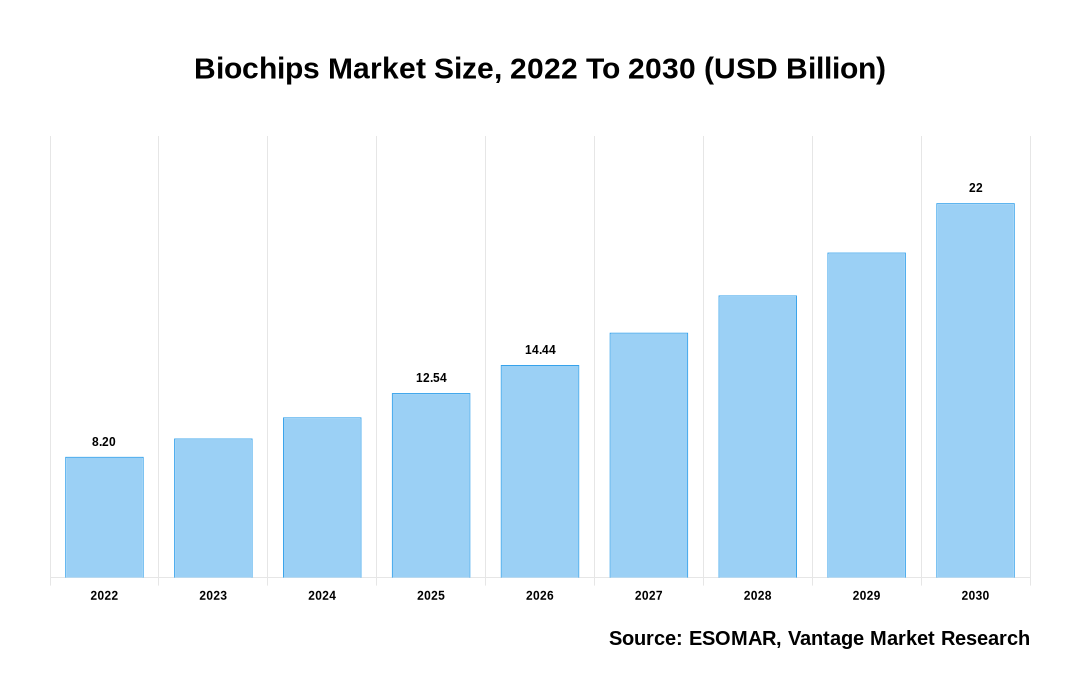Global Biochips Market
As stated in our extensive report; the Global Biochips Market accounted for USD 8.2 Billion in the year 2022.
The biochip market is quickly becoming a hub for maturing new businesses. This is due to increased drug development, greater use of tailored medications, and next-generation sequencing (NGS). The progress of microfluidic-based gadgets in biomedicine and innovation in Lab-on-a-Chip products are anticipated to fuel industry expansion. LOC devices are expected to provide quick findings for diagnosing infectious infections for the first time. In epidemiological investigations, the technology is commonly used. The COVID-19 pandemic’s influence on public health and the biochip supply chain led to an imbalance in supply and demand. With assistance from academic institutions and biopharma businesses, product demand expanded. Before going through clinical trials, medications are tested on biochips. The Viennese University of Technology (TU Wien) created a biochip-based technology in May 2022 that enables the production of tissue beads in exact sizes and commercializes those beads and pharmaceuticals through a narrow route.

Click To Get a Free Sample On the Research Study
Moreover, a patent application has been filed for this technique. However, the expense of producing biochips may limit the industry’s expansion. The bulk of microfluidic devices is created using ultraviolet lithography, a costly and complicated process that calls for skilled experts and specialized equipment.
Factors Influencing Global Biochips Market Growth
The growth of the global Biochips market can be attributable to the following:
- Growing incidences of viral infections, immunological disorders, and cancer are the main factors propelling the growth of the global biochips market.
- The aging population leading to increased biochip applications, and widespread use of tailored pharmaceuticals drive the market’s growth.
- The growing demand for quicker response times and smaller biological and clinical tests for use in research and diagnostics, a broad product range, rapid technological advancements connected to biochip and bio-array techniques, and rising demand for these techniques all contribute to the market growth for biochips.
- The use of biochips in numerous applications, including the identification of disease markers and the acceleration of drug development, as well as multiple research applications in the fields of genotyping, proteomics, and genomics, as well as an increase in clinical research spending and significant resource allocation for genomic and proteomic research, have a positive impact on the biochips market.
- Government funding, a surge in R&D spending, and the enormous untapped market potential in emerging economies will all likely create profitable market expansion prospects.
On the other hand, barriers to commercial expansion include the expensive cost of biochips and a general lack of awareness of them in emerging economies.
North America Region to Take Over the Market
The North America region is anticipated to dominate the worldwide biochips market. The presence of cutting-edge technology in the area and various contributing variables like the rise in government attempts to boost R&D operations through increased tax credits will increase the market value. Also, the US has an R&D tax credit that serves as a budgetary benefit and enables businesses to do various research activities for developing, enhancing, and innovating products and formulas. This results in an ongoing development cycle, further supporting the market’s expansion.
Conclusion
The increased use of biochips and the adoption of personalized medicine has favorably impacted the total Biochips market sales.
The well-known players of the Global Biochips Market include Thermo Fisher Scientific Inc. (U.S.), Abbott Laboratories (U.S.), Agilent Technologies Inc. (U.S.), PerkinElmer Inc. (U.S.), Fluidigm Corporation (U.S.) and others.
![[Market Research Reports] – Research Google News Blog | VMR.Biz](https://www.vmr.biz/wp-content/uploads/2022/12/logo-removebg-preview.png)











